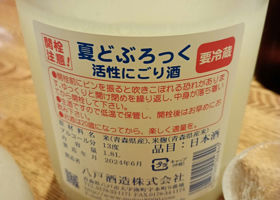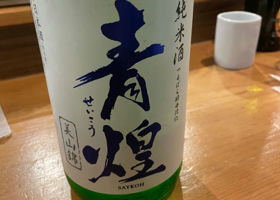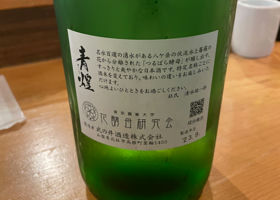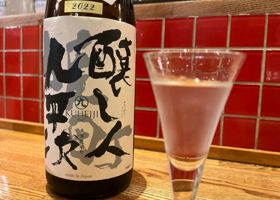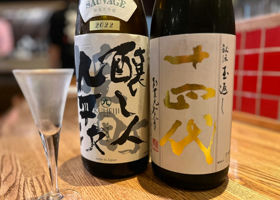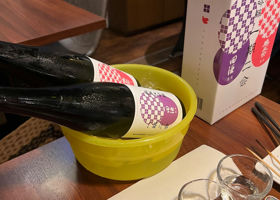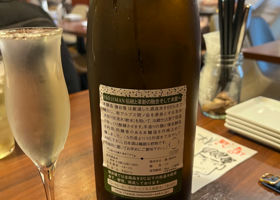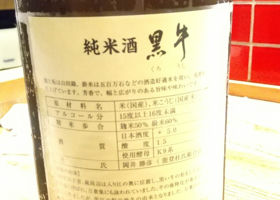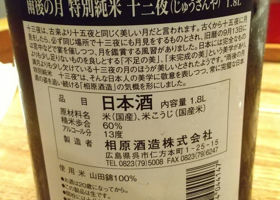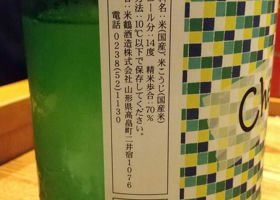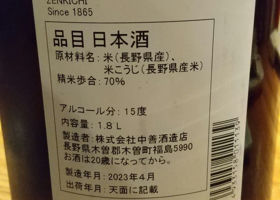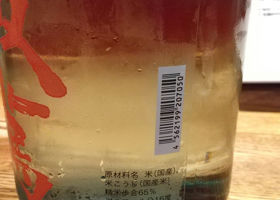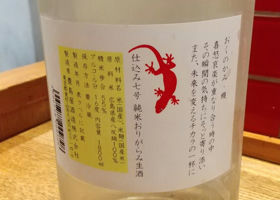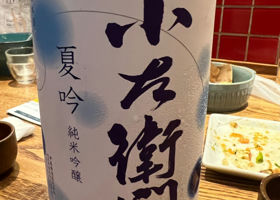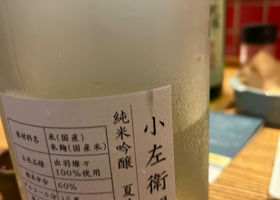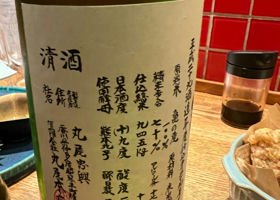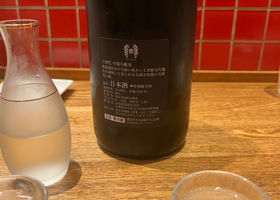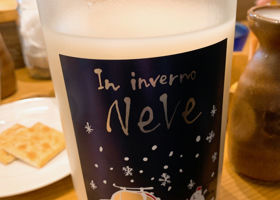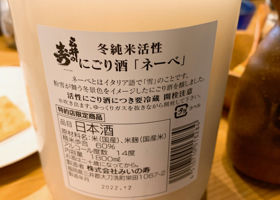Timeline
JuleCarbonation and sweet and sour taste,
Muddy feeling of Ori
Slightly sweet but refreshing
Aomori rice
Rice polishing ratio: 55
Alcohol content: 13%.
@Mr. Happy yossieBrewer Kuheiji‼︎ no~ cool! 🎉
Oumachi in gray behind the words Kuheiji! 🌾.
It's already decidedly delicious! 🤩.
I found it to be both sweet and spicy, a well-balanced and solid sake 😋I would like to drink it again and again when I have a more discerning palate 😊. じゅんさんA new unit AQE (Aomori Quattro Experanza) has been formed by volunteer breweries in Aomori Prefecture, and we are buying bottles of sake from a sake bar in Jimbocho that is exclusive to special distributors of the new sake rice-themed project product "Ichigo-Futae - Aomori Sake Rice Project.
Drunkenness in summer is scary!
Ichigo Futakai Tasake & Kyu Masamune Junmai Daiginjo "Toyobai Rice 48
Aomori's second best rice for sake brewing, "Toyohai". Miura Shuzo grows Toyohai under contract and continues to brew sake, and now Tasake and Hato Masamune are pairing up to make a Junmai Daiginjo using this sake rice.
The second bottle is
Hato Masamune Junmai Daiginjyo Toyobai Rice 48
I like it very much because it has a refreshing, slightly effervescent taste and just the right amount of throatiness!
Rice used: Toyobai rice produced in Aomori City
Polishing ratio: 48
Sake meter: -0.5
Acidity: 1.1
Alcohol content: 16 
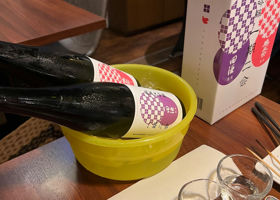
じゅんさんA new unit AQE (Aomori Quattro Experanza) has been formed by volunteer breweries in Aomori Prefecture, and we are buying bottles of sake from a sake bar in Jimbocho that is exclusive to special distributors of the new sake rice-themed project product "Ichigo-Futae - Aomori Sake Rice Project.
Drunkenness in summer is scary!
Ichigo Futakai Tasake & Kyu Masamune Junmai Daiginjo "Toyobai Rice 48
Aomori's second best rice for sake brewing, "Toyohai". Miura Shuzo grows Toyohai under contract and continues to brew sake, and now Tasake and Hato Masamune are pairing up to make a Junmai Daiginjo using this sake rice.
One is
Tasake Junmai Daiginjo Toyobai Rice 48
The first one is "Tasake Junmai Daiginjo Toyobai Mai 48" which has a clear and well-balanced flavor with no impurities. It is a very tasty sake that goes down smoothly.
Rice used: Toyobai rice grown in Aomori City
Polishing ratio: 48
Sake meter degree: +1.0
Acidity: 1.7
Alcohol content: 16
じゅんさんTensei Senpou "Summer" Junmai Ginjyo Namaizumi
The blue color of the bottle and the clean, refreshing taste make this a truly summery bottle!
It's so fitting that this is made by a brewery in Chigasaki!
The slightly lower alcohol content also helps, which is good for hot summers.
Polishing ratio 50%.
Sake meter --- Sake meter --- Acidity --- Acidity
Acidity --- 14
Degree of alcohol by volume 14 degrees じゅんさんI had a bottle of Isobojumi Honjozo.
It is very clean and smooth and comes in a mini wine glass at this restaurant.
One that I would like to drink again.
Grape variety: Kiyonishiki, Yamagata Prefecture (Tome Kake rice: Yamadanishiki, Hyogo Prefecture)
Polishing ratio 65 JuleMild aroma
Full-bodied, with some bran
Yamadanishiki (Koji), Sake brewing rice (Kake)
Polishing ratio : 50% (Koji), 60% (Kake)
Yeast : Association No.9
Sake meter degree: +5.0
Acidity: 1.5
Alcoholic Beverage: 15 to 16 degrees Celsius
715/120ml Jule◎
Melon-like ginjo aroma
Good balance of sweetness and bitterness, very tasty.
Special A Yamadanishiki produced in Hyogo Prefecture
Rice polishing ratio: 60
Alcohol content: 13%.
830/120ml JuleEasy to drink with a refreshing taste
Domestic rice
Polishing ratio: 70
Yeast: YK009
Alcohol content: 14%.
715/120ml JuleClean and refreshing taste
Well-rounded and goes well with meat
Miyamanishiki produced in Matsukawa Village, Kita-Anumo District
Rice polishing ratio: 70
Alcohol content: 15%.
715/120ml JuleMelon-type aroma
Slightly methylated
Suitable for meat-based snacks
Gohyakumangoku (Koji), Koshibuki (Kake)
Rice polishing ratio: 65
Yeast: K-1401, Sake meter rating: +10
Acidity: 1.8
Alcohol percentage: 16
715/120ml JuleRefreshing ginjo aroma
Good balance of moderate sweetness and rice flavor
Hachitan-Nishiki produced in Hiroshima Prefecture
Rice polishing ratio: 55
Alcohol content: 16%.
830/120ml じゅんさんAfter all, a clear and refreshing sake is good on such a hot day. So, here is the last one, Koza's summer limited edition sake! Summer Gin.
It was well received by women in their 20s.
Well, it is an easy-drinking sake.
Rice: Dewasanbaku (produced in Yamagata Prefecture)
Rice polishing ratio 60
Sake degree: around -3
Acidity: around 1.6
Alcohol content: 14%.
Specifications Junmai Ginjo
Produced in Mizunami City, Gifu Prefecture, Japan じゅんさんEtsukaijin was selected as a sake with a dry and umami flavor, which is quite different from Jyushidai.
This sake was quite different from the Jyushidai, as it was dry and full-bodied, making me want to eat stewed rice.
It was not popular among the 20-something women in attendance. I see, they like gorgeous sake after all.
Rice used: Kame-no-o from Ebina
Polishing ratio 70%.
Yeast used: Kumamoto No. 9
State: Yamahai, unfiltered, raw sake
Alcohol content 17-18%.
Sake degree +6
Acidity 2.4
Amino acidity 1.6
じゅんさんI found this sake at Mr. Happy, a sake bar in Jimbocho that is open on Sundays.
It is sold for quite a high price on the Internet, but here you can drink it for a reasonable price if you are lucky.
On such a Sunday night, I enjoyed 2 gou including refills. Well, it was a good experience!
Oh, the taste? It's so delicious that even 20-somethings who have just started drinking sake are drawn to it.
Ingredients: rice, rice malt
Rice used: 100% domestic rice
Rice polishing ratio: 55
Alcohol content: 15
Brewer:Takagi Shuzo Co. RecommendedContentsSectionView.title
